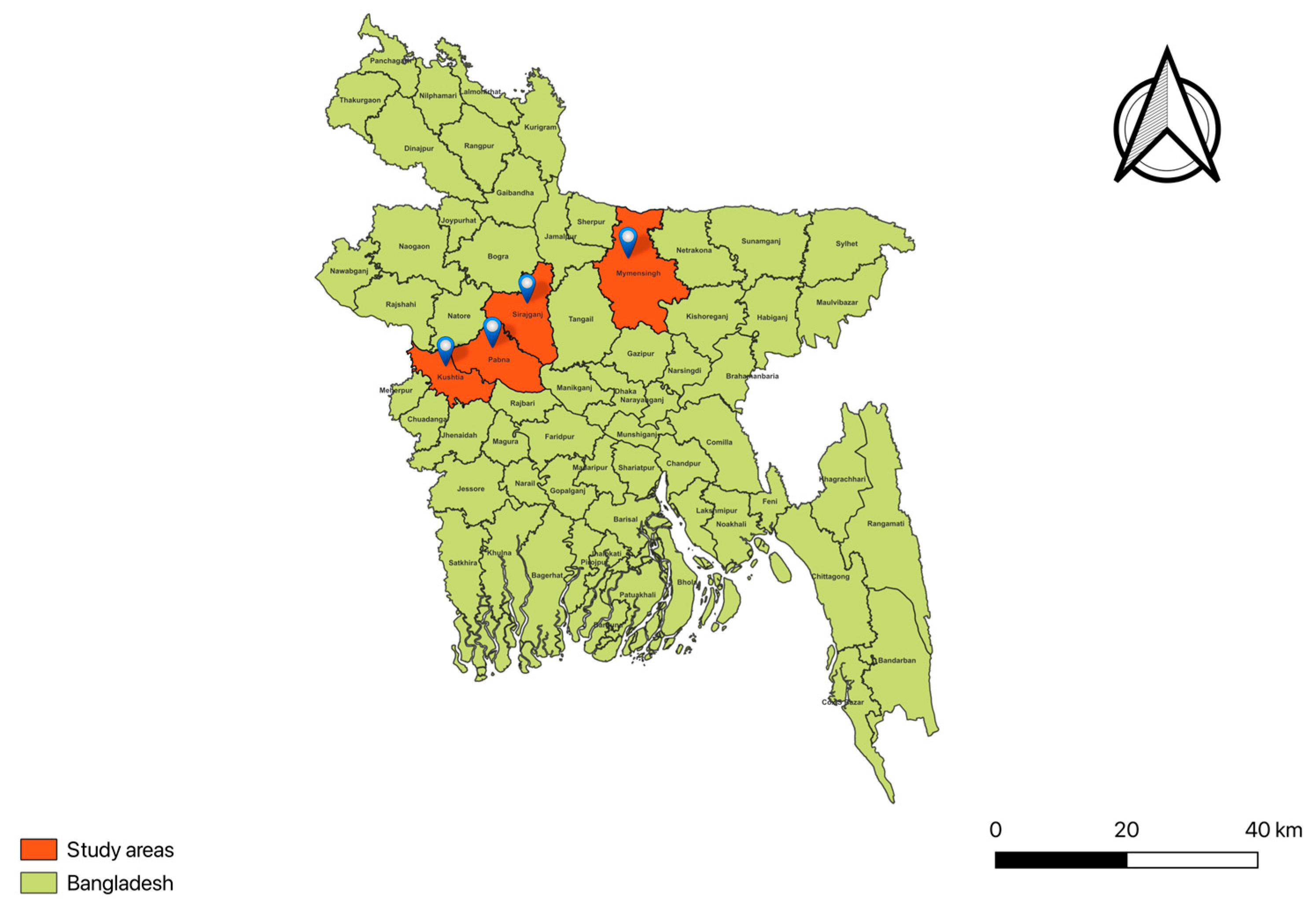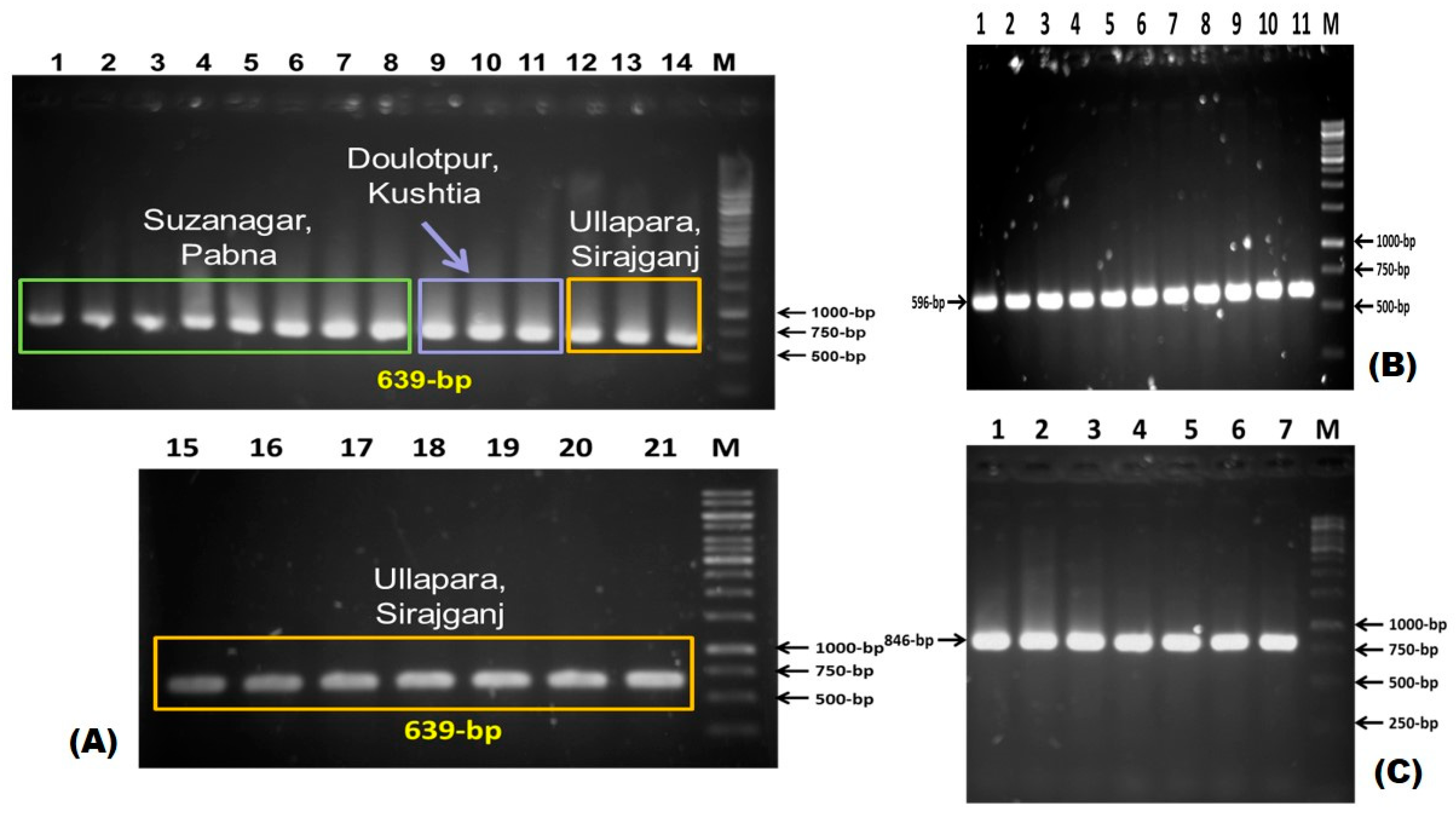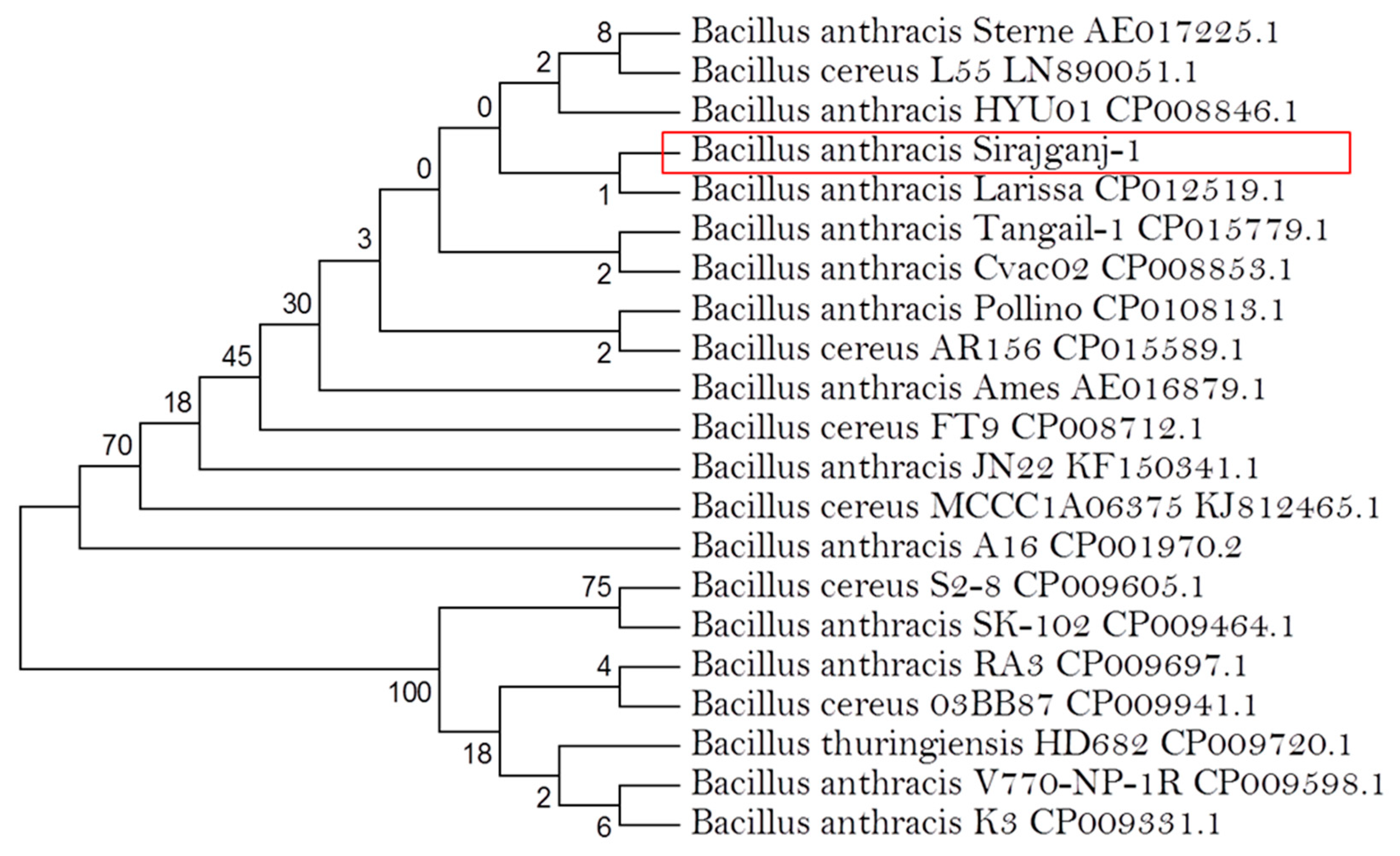Molecular Characterization of Bacillus anthracis from Selected Districts of Bangladesh
Abstract
1. Introduction
2. Materials and Methods
2.1. Sample Collection
2.2. Cultural Identification
2.3. Extraction of Genomic DNA
2.4. Amplification of Sap, Protective Antigen (PA) of pX01, Capsule (pX02), and 16S rRNA Genes
2.5. Sequencing of PCR Products
3. Results and Discussion
4. Conclusions
Author Contributions
Funding
Institutional Review Board Statement
Informed Consent Statement
Data Availability Statement
Acknowledgments
Conflicts of Interest
References
- Turnbull, P.; Quinn, C.; Henderson, I. Bacillus anthracis and Other Bacillus species. In Molecular Medical Microbiology; Elsevier: Amsterdam, The Netherlands, 2002; Volume 3, pp. 2011–2031. ISBN 978-0-12-677530-3. [Google Scholar]
- Moazeni Jula, G.R.; Jabbari, A.R.; Malek, B. Isolation of anthrax spores from soil in endemic regions of Isfahan, Iran. Arch. Razi Inst. 2004, 58, 29–38. [Google Scholar]
- Biswas, P.K.; Islam, M.Z.; Shil, S.K.; Chakraborty, R.K.; Ahmed, S.S.U.; Christensen, J.P. Risk factors associated with anthrax in cattle on smallholdings. Epidemiol. Infect. 2012, 140, 1888–1895. [Google Scholar] [CrossRef]
- Hassan, J.; Ahsan, M.; Rahman, M.; Chowdhury, S.; Parvej, M.; Nazir, K. Factors associated with repeated outbreak of anthrax in Bangladesh: Qualitative and quantitative study. J. Adv. Vet. Anim. Res. 2015, 2, 158–164. [Google Scholar] [CrossRef]
- Oaks, J.L.; Gilbert, M.; Virani, M.Z.; Watson, R.T.; Meteyer, C.U.; Rideout, B.A.; Shivaprasad, H.L.; Ahmed, S.; Iqbal Chaudhry, M.J.; Arshad, M.; et al. Diclofenac residues as the cause of vulture population decline in Pakistan. Nature 2004, 427, 630–633. [Google Scholar] [CrossRef]
- Nazir, K.; Hassan, J.; Chowdhury, S.; Rahman, M. Novel multiplex-PCR for rapid detection of Bacillus anthracis spores present in soils of Sirajganj district in Bangladesh. Progress. Agric. 2015, 26, 67–70. [Google Scholar] [CrossRef]
- Sarker, M.S.A.; El Zowalaty, M.E.; Shahid, M.A.H.; Sarker, M.A.; Rahman, M.B.; Järhult, J.D.; Nazir, K.H.M.N.H. Maximization of Livestock Anthrax Vaccination Coverage in Bangladesh: An Alternative Approach. Vaccines 2020, 8, 435. [Google Scholar] [CrossRef]
- Sarker, M.S.A.; Shahid, M.A.H.; Nazir, K.H.M.N.H. Efficaciousness of Sterne 34F-2 strain of Bacillus anthracis vaccine in cattle for anthrax control program in Bangladesh. J. Istanb. Vet. Sci. 2021, 5, 32–38. [Google Scholar] [CrossRef]
- Carlson, C.J.; Kracalik, I.T.; Ross, N.; Alexander, K.A.; Hugh-Jones, M.E.; Fegan, M.; Elkin, B.T.; Epp, T.; Shury, T.K.; Zhang, W.; et al. The global distribution of Bacillus anthracis and associated anthrax risk to humans, livestock and wildlife. Nat. Microbiol. 2019, 4, 1337–1343. [Google Scholar] [CrossRef]
- Zihad, M.; Shahid, M.; Mahmud, M.; Kabir, A.; Kamal, M.; Naim, J.; Hossen, M.; Nazir, K. Molecular detection, antibiogram, and risk factor analysis of Staphylococcus aureus from subclinical mastitis of goats in conventional and organized farms. Vet. Res. Notes 2021, 1, 17–22. [Google Scholar] [CrossRef]
- Islam, M.; Mahmud, M.; Yesmin, S.; Islam, M.; Sarker, M.; Nazir, K. Risk Factors Assessment of Zoonotic Anthrax among the People at Risk (PAR) in Selected Areas of Bangladesh. Asian J. Med. Health 2017, 4, 1–7. [Google Scholar] [CrossRef]
- Farhad, S.; Shahid, M.; Mahmud, M.; Kabir, A.; Das, S.; Rahman, M.; Nazir, K. Molecular detection and antibiogram of Escherichia coli O157 isolated from subclinical mastitis affected cows at Baghabari, Sirajganj. Vet. Res. Notes 2021, 1, 6–11. [Google Scholar] [CrossRef]
- Dragon, D.C.; Rennie, R.P.; Elkin, B.T. Detection of anthrax spores in endemic regions of northern Canada. J. Appl. Microbiol. 2001, 91, 435–441. [Google Scholar] [CrossRef]
- Sarker, M.S.A.; Shahid, M.A.H.; Hoque, M.N.; Sarker, M.A.; Rahman, M.B.; Islam, S.S.; Nazir, K.H.M.N.H. The The Rich Mapping: Be a Supplementary Approach for Anthrax Control at Community Level. J. Adv. Vet. Res. 2021, 11, 41–46. [Google Scholar]
- Sarker, M.S.A.; Shahid, M.A.H.; Rahman, M.B.; Nazir, K.H.M.N.H. An integrated model for anthrax-free zone development in developing countries. J. Infect. Public Health 2023, 16, 141–152. [Google Scholar] [CrossRef]
- Cheun, H.I.; Makino, S.-I.; Watarai, M.; Erdenebaatar, J.; Kawamoto, K.; Uchida, I. Rapid and effective detection of anthrax spores in soil by PCR. J. Appl. Microbiol. 2003, 95, 728–733. [Google Scholar] [CrossRef]
- Khan, M.; Pavel, M.; Keya, A.; Shahid, M.; Ferdausi, T.; Siddique, M.; Hossain, M.; Nazir, K.; Rahman, M.; Rahman, M. Comparative molecular analysis of contemporary isolates of duck plague virus from haor areas of Bangladesh. J. Adv. Biotechnol. Exp. Ther. 2021, 4, 44–52. [Google Scholar] [CrossRef]
- Mahmud, M.M.; Iqbal, M.A.; Shahid, M.A.H.; Das, S.; Kabir, A.; Hossain, M.Z.; Hasan, A.; Raihan, A.; Yadav, R.; Rahman, A.K.M.A. Bovine Foot-and-Mouth-Disease risk factors in Mymensingh district of Bangladesh. Bangladesh J. Vet. Med. 2022, 20, 43–48. [Google Scholar] [CrossRef]
- Ahsan, M.M.; Rahman Khan, M.F.; Rahman, M.B.; Chowdhury, M.Z.H.; Parvej, M.S.; Jahan, M.; Nazir, K.H.M.N.H. Investigation into Bacillus anthracis spore in soil and analysis of environmental parameters related to repeated anthrax outbreak in Sirajganj, Bangladesh. Thai J. Vet. Med. 2013, 43, 449–454. [Google Scholar] [CrossRef]
- Shahid, A.H.; Nazir, K.H.M.N.H.; El Zowalaty, M.E.; Kabir, A.; Sarker, S.A.; Siddique, M.P.; Ashour, H.M. Molecular detection of vancomycin and methicillin resistance in Staphylococcus aureus isolated from food processing environments. One Health 2021, 13, 100276. [Google Scholar] [CrossRef]
- Meghla, N.S.; Mridha, D.; Rana, M.S.; Shahid, M.A.H.; Mahmud, M.M. Isolation, identification and antibiogram of verotoxin producing Escherichia coli from raw salad vegetables at Jashore, Bangladesh. Afr. J. Microbiol. Res. 2021, 15, 401–407. [Google Scholar] [CrossRef]
- Sacchi, C.T.; Whitney, A.M.; Mayer, L.W.; Morey, R.; Steigerwalt, A.; Boras, A.; Weyant, R.S.; Popovic, T. Sequencing of 16S rRNA Gene: A Rapid Tool for Identification of Bacillus anthracis. Emerg. Infect. Dis. 2002, 8, 1117–1123. [Google Scholar] [CrossRef] [PubMed]
- Schmid, G.; Kaufmann, A. Anthrax in Europe: Its epidemiology, clinical characteristics, and role in bioterrorism. Clin. Microbiol. Infect. 2002, 8, 479–488. [Google Scholar] [CrossRef] [PubMed]
- Turner, A.J.; Galvin, J.W.; Rubira, R.J.; Condron, R.J.; Bradley, T. Experiences with vaccination and epidemiological investigations on an anthrax outbreak in Australia in 1997. J. Appl. Microbiol. 1999, 87, 294–297. [Google Scholar] [CrossRef] [PubMed]
- Levings, R.L. Emerging and Exotic Zoonotic Disease Preparedness and Response in the United States—Coordination of the Animal Health Component. Zoonoses Public Health 2012, 59, 80–94. [Google Scholar] [CrossRef]
- Chikerema, S.M.; Pfukenyi, D.M.; Hang’ombe, B.M.; L’Abee-Lund, T.M.; Matope, G. Isolation of Bacillus anthracis from soil in selected high-risk areas of Zimbabwe. J. Appl. Microbiol. 2012, 113, 1389–1395. [Google Scholar] [CrossRef]
- WHO. Anthrax in Humans and Animals. Available online: https://www.who.int/publications/i/item/9789241547536 (accessed on 20 April 2024).
- CDC. Human Anthrax Associated with an Epizootic Among Livestock-North Dakota, 2000. Available online: https://www.cdc.gov/mmwr/preview/mmwrhtml/mm5032a1.htm (accessed on 20 April 2024).



| Primer Name | Gene Targeted | Primer Sequence (5′-3′) | Amplicon Size (bp) | Reference |
|---|---|---|---|---|
| Sap-1 | Sap in genomic DNA | CGCGTTTCTATGGCATCTCTTCT | 639 bp | [14] |
| Sap-2 | TTCTGAAGCTGGCGTTACAAAT | |||
| Pag-5 | Protective antigen (pX01) | TCCTAACACTAACGAAGTCG | 596 bp | |
| Pag-8 | GAGGTAGAAGGATATACGGT | |||
| Cap-1 | Capsule (pX02) | CTGAGCCATTAATCGATATG | 846 bp | |
| Cap-2 | TCCCACTTACGTAATCTCTTCT | |||
| 8 F | 16S rRNA | AGTTGATCCTGGCTCAG | 1504 bp | [22] |
| 1492 R | ACCTTGTTACGACTT |
| Sampling Area | Sample Type | Examine (N) | Positive (N) | Prevalence (%) |
|---|---|---|---|---|
| Suzanagar, Pabna | Soil | 20 | 8 | 40 |
| Doulotpur, Kushtia | Soil | 28 | 3 | 10.71 |
| Mymensingh | Soil | 50 | 0 | 0 |
| Ullapara, Sirajganj | Soil | 30 | 10 | 20 |
| Total | 128 | 21 | 16.40 | |
| Suzanagar, Pabna | Blood | 1 | 1 | 100 |
| Kamarkhand, Sirajganj | Meat | 1 | 1 | 100 |
| Ullapara, Sirajganj | Meat | 1 | 1 | 100 |
| Total | 3 | 3 | 100 |
| Location | Samples Collected | Positive by PCR | pX01 | pX02 | pX01 + pX02 |
|---|---|---|---|---|---|
| Suzanagar, Pabna | 20 | 8 | 3 | 4 | 1 |
| Doulotpur, Kushtia | 28 | 3 | 2 | 1 | - |
| Mymensingh | 50 | - | - | - | - |
| Ullapara, Sirajganj | 30 | 10 | 6 | 2 | 2 |
| Total | 128 | 21 | 11 | 7 | 3 |
Disclaimer/Publisher’s Note: The statements, opinions and data contained in all publications are solely those of the individual author(s) and contributor(s) and not of MDPI and/or the editor(s). MDPI and/or the editor(s) disclaim responsibility for any injury to people or property resulting from any ideas, methods, instructions or products referred to in the content. |
© 2025 by the authors. Published by MDPI on behalf of the Hellenic Society for Microbiology. Licensee MDPI, Basel, Switzerland. This article is an open access article distributed under the terms and conditions of the Creative Commons Attribution (CC BY) license (https://creativecommons.org/licenses/by/4.0/).
Share and Cite
Islam, M.M.; Shahid, M.A.H.; Nazir, K.H.M.N.H. Molecular Characterization of Bacillus anthracis from Selected Districts of Bangladesh. Acta Microbiol. Hell. 2025, 70, 17. https://doi.org/10.3390/amh70020017
Islam MM, Shahid MAH, Nazir KHMNH. Molecular Characterization of Bacillus anthracis from Selected Districts of Bangladesh. Acta Microbiologica Hellenica. 2025; 70(2):17. https://doi.org/10.3390/amh70020017
Chicago/Turabian StyleIslam, Md. Maidul, Md Ahosanul Haque Shahid, and K. H. M. Nazmul Hussain Nazir. 2025. "Molecular Characterization of Bacillus anthracis from Selected Districts of Bangladesh" Acta Microbiologica Hellenica 70, no. 2: 17. https://doi.org/10.3390/amh70020017
APA StyleIslam, M. M., Shahid, M. A. H., & Nazir, K. H. M. N. H. (2025). Molecular Characterization of Bacillus anthracis from Selected Districts of Bangladesh. Acta Microbiologica Hellenica, 70(2), 17. https://doi.org/10.3390/amh70020017








